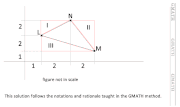What is the area of a triangle with the following vertices L(1, 3), M(5, 1), and N(3, 5)?
A. 3
B. 4
C. 5
D. 6
E. 7
The OA is D.
Basically, vertices are L(1, 3), M(5, 1), and N(3, 5), since only area is asked here we can subtract 1 from each of the x and y co-ordinates which makes the new points as L(0, 2), M(4, 0), and N(2, 4) which makes it a right-angled traingle framed on the x and y axes with corner at N(2, 4). i t wouldn't be hard to calculate the area of new traingle as 4sq.units.
Has anyone another strategic approach to solve this PS question? Regards!
What is the area of a triangle with the following vertices
This topic has expert replies
-
deloitte247
- Legendary Member
- Posts: 2214
- Joined: Fri Mar 02, 2018 2:22 pm
- Followed by:5 members
I f the vertices o a triangle are :
A (ax, ay), B (bx, by), C (cx, cy)
Then area of ABC is
$$Area\ =\ \frac{\left(ax\left(by\ -\ cy\right)+\ bx\ \left(cy\ -\ ay\right)+\ cx\ \left(ay\ -\ by\right)\right)}{2}$$
Given that ;
L(1,3), M(5,1), N(3,5)
$$Area\ =\ \frac{\left(1\left(1-5\right)+5\left(5-3\right)+3\left(3-1\right)\right)}{2}$$
$$Area\ =\ \frac{\left(-4\ +\ \left(25-15\right)+\left(9-3\right)\right)}{2}$$
$$Area\ =\ \frac{\left(-4+10+6\right)}{2}$$
$$Area\ =\ \frac{\left(-4+16\right)}{2}$$
$$Area\ =\ \frac{12}{2}$$
Area = 6
Option D is CORRECT.
A (ax, ay), B (bx, by), C (cx, cy)
Then area of ABC is
$$Area\ =\ \frac{\left(ax\left(by\ -\ cy\right)+\ bx\ \left(cy\ -\ ay\right)+\ cx\ \left(ay\ -\ by\right)\right)}{2}$$
Given that ;
L(1,3), M(5,1), N(3,5)
$$Area\ =\ \frac{\left(1\left(1-5\right)+5\left(5-3\right)+3\left(3-1\right)\right)}{2}$$
$$Area\ =\ \frac{\left(-4\ +\ \left(25-15\right)+\left(9-3\right)\right)}{2}$$
$$Area\ =\ \frac{\left(-4+10+6\right)}{2}$$
$$Area\ =\ \frac{\left(-4+16\right)}{2}$$
$$Area\ =\ \frac{12}{2}$$
Area = 6
Option D is CORRECT.
- fskilnik@GMATH
- GMAT Instructor
- Posts: 1449
- Joined: Sat Oct 09, 2010 2:16 pm
- Thanked: 59 times
- Followed by:33 members
I suggest subtracting from the area of a 4x4 square the sum of three right triangles (Si, Sii and Siii):AAPL wrote:What is the area of a triangle with the following vertices L(1, 3), M(5, 1), and N(3, 5)?
A. 3
B. 4
C. 5
D. 6
E. 7
\[? = 16 - \left( {{S_{\,{\text{I}}}} + {S_{\,{\text{II}}}} + {S_{\,{\text{III}}}}} \right)\]
\[{S_{\,{\text{I}}}}\,\, = \,\,\frac{{2 \cdot 2}}{2} = 2\,\,\,\,\,\,\,;\,\,\,\,\,\,\,\,{S_{\,{\text{II}}}} = \,\,\frac{{2 \cdot 4}}{2} = {S_{\,{\text{III}}}} = 4\,\]
\[? = 16 - 10 = 6\]
(See figure attached.)
This solution follows the notations and rationale taught in the GMATH method.
Regards,
fskilnik.

Fabio Skilnik :: GMATH method creator ( Math for the GMAT)
English-speakers :: https://www.gmath.net
Portuguese-speakers :: https://www.gmath.com.br
English-speakers :: https://www.gmath.net
Portuguese-speakers :: https://www.gmath.com.br
GMAT/MBA Expert
- Brent@GMATPrepNow
- GMAT Instructor
- Posts: 16207
- Joined: Mon Dec 08, 2008 6:26 pm
- Location: Vancouver, BC
- Thanked: 5254 times
- Followed by:1268 members
- GMAT Score:770
Now that you know the technique, you can practice your speed with this one: https://www.beatthegmat.com/coordinate-g ... 16975.html
Cheers,
Brent
Cheers,
Brent




















